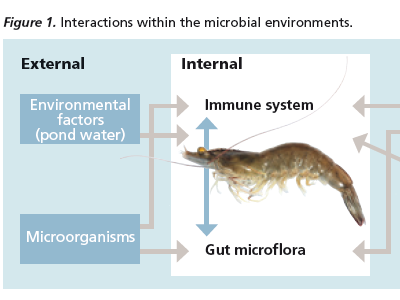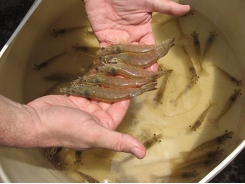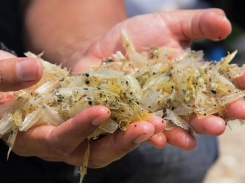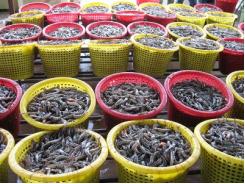Probiotics: An Essential Tool in Intensive Shrimp Aquaculture

As aquaculture develops, the industry faces several challenges related to its environmental impact. The application of beneficial bacteria (probiotics) is not only associated with gut health (feed probiotics), but also with bioremediation that improves the environment (water and soil) in which the animals are reared, writes Gonçalo Santos, R&D Manger, Aquaculture, Biomin.
A key factor for successful aquaculture is to understand the interactions between the microbial environment, gut flora and immune system of the shrimp, as well as factors that determine the persistence of microbial species in the internal and external microbial ecosystems (Figure 1). While natural eco-systems are balanced, the farming environment favours the growth of microorganisms as it is rich in nutrients and feed waste.
This environmental challenge is influenced by different factors, including farm management and rearing methods. Aquaculture operations generally involve the stocking and feeding of shrimp in open or semi-closed water systems. Semi-closed pond systems have a low water turnover and can accumulate nutrients, metabolites and waste, which deteriorate water quality and create anoxic conditions in the soil.
Pond management
The accumulation of waste compounds favours the growth of potentially harmful microorganisms while impacting the performance of farmed species. Good pond management is crucial for high production and a healthy crop. As water quality plays an important role, it is of great value to understand the various interactions taking place within the ponds. These are quite complex and depend directly on the pond environment, stocked biomass, input of nutrients and pond management.
Table 1: Summary of pond interactions with and without the addition of beneficial bacteria
| Effect on | Without beneficial bacteria | With beneficial bacteria |
| Feed waste, faeces and organic matter | Accumulation | Reduction |
| Ammonia (NH3), Nitrogen dioxide (NO2), Hydrogen sulphide (H2S) | Increase | Decrease |
| Oxygen (O2) | Decrease | Increase |
| Eutrophication | Increase Contaminated pond, water and bottom | Decrease Improved pond, water and bottom |
| Pathogen and disease | Increase | Decrease |
| Shrimp growth and crop | Decrease | Increase |
The accumulation and degradation of organic waste in the pond increases the consumption of oxygen (O2) and production of waste compounds such as ammonia (NH3), nitrites (NO2-) and hydrogen sulphide (H2S), which can lead to a phytoplankton bloom. The massive growth of
phytoplankton can further deplete oxygen during the night and contribute to a phytoplankton bloom crash.
All these factors contribute to the contamination of water and soil, creating favourable conditions for pathogens to grow and affecting the condition of shrimp. Under such poor conditions, shrimp face higher levels of stress and are more susceptible to disease, which could result in poor growth or a failed crop through disease outbreaks (Table 1).
Table 2: A diverse range of enzymes used as bioremediation agents in aquaculture
| Enzyme | Substrate |
| Amylase | Starch |
| Beta-Glucosidase | Beta-Glucoside |
| Cellulase | Cellulose |
| Lipase | Lipids and fat |
| Protease | Protein |
| Xylanase | Xylan, Hemicellulose |
| Pectinase | Pectin |
With the inclusion of beneficial bacteria, organic matter is utilised as a source of nutrients by the bioremediation bacteria. Th is reduces the amount of waste accumulating in the pond. Specific nitrifying and denitrifying bacteria will convert NH3 and NO2- into nitrogen gas, reducing the level of such toxic compounds. Some beneficial bacteria can also degrade toxic H2S, improving water quality and odour. The combination of all these factors will improve water quality and the condition of the pond soil, resulting in a better environment for shrimp with better growth and health status.
Enzymes
In the bioremediation process, enzymes play the role of catalysts that accelerate biochemical reactions in pond soil and water. When added to culture water or spread on top of pond soil, enzymes are able to degrade the major organic constituents normally found in shrimp and fish ponds. Each enzyme has its mode of action and is very specific in the chemical reaction it catalyses (Table 2).
Enzymes are also naturally produced and excreted by some microbes. These extracellular enzymes, such as cellulase, protease and amylase, are produced during the aerobic fermentation of organic matter by micro-organisms, for example by some Bacillus species.
Bacilli are commonly found in pond sediments and can also be added to the pond water for bioremediation purposes. Some Bacillus sp. are also able to degrade nitrogenous compounds and their large variety of excreted (extracellular) enzymes also helps to speed up the degradation of organic matter and toxic compounds such as ammonia. Efficient removal of nitrogenous compounds can also be carried out by nitrifying and denitrifying bacteria such as Thiobacillus and Paracoccus.

Field study
In a field study in China, the combined application of the bioremediation products AquaStar® Pond (multi-strain beneficial bacteria) and AquaStar® Pond-Zyme (beneficial bacteria and an enzyme blend) were added to the water. It was observed that water quality improved, as did soil condition and ultimately, shrimp performance.
Four earth shrimp ponds (0.7-0.8 ha/pond) with a depth of 1-1.2 m were stocked with juvenile shrimp (approximately 1.4 g/shrimp) at a density of 50 shrimp/m². The trial was carried out for a period of 57 days with an application of 1 kg/ha AquaStar® Pond weekly and 500 g/ha of AquaStar® PondZyme applied once a month to the treatment group (two ponds). The control ponds consisted of two ponds with normal production operations.
The soil of the AquaStar® ponds in Figure 2 (A) was yellow, the colour which represents the best bottom type. The soil of the control ponds in Figure 2 (B) however, exhibited a dark black color, indicating the accumulation of dead organic matter.
Results suggested that with the combined use of beneficial bacteria and enzymes, pond soils containing black and glutinous organic sludge turned into a yellowish soil.

In terms of performance, the average daily weight gain of shrimp in the AquaStar® group was higher by 36% and feed conversion ratio was lower by 9% compared to the control ponds. The results are shown in Figure 3 and 4.


Based on these results, it was concluded that in the search for more effective and environmentally-friendly treatments, beneficial bacteria have emerged as a viable alternative. Enzymes can play a complimentary role in bioremediation solutions for aquaculture, especially in intensive productions.
Related news
Tools

Phối trộn thức ăn chăn nuôi

Pha dung dịch thủy canh

Định mức cho tôm ăn

Phối trộn phân bón NPK

Xác định tỷ lệ tôm sống

Chuyển đổi đơn vị phân bón

Xác định công suất sục khí

Chuyển đổi đơn vị tôm

Tính diện tích nhà kính

Tính thể tích ao




 Regular population sampling of shrimp in ponds, part…
Regular population sampling of shrimp in ponds, part…  A holistic management approach to EMS
A holistic management approach to EMS